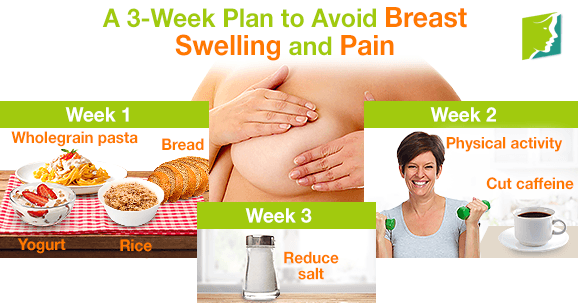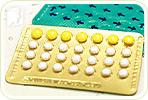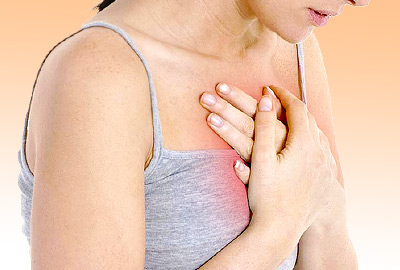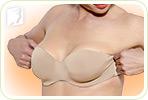Breast swelling and pain affect the majority of women at some point in their lives. The cause of breast swelling is commonly hormonal fluctuations, but there are other factors, too, such as exercise habits, genetic predisposition, and diet. Self-help treatments are normally recommended as the best way to start treating breast swelling and pain because they are inexpensive, safe, and healthy. The following three-week plan incorporates the self-help remedies that have been shown to work in many women. Read on to find out how to gradually introduce lifestyle habits to reduce breast swelling and pain.
Week 1
A diet high in fat and processed foods has been linked to breast pain, so the first step is to avoid buying any in your next shopping trip. As a general rule of thumb, processed foods are pre-prepared meals, like frozen or ready meals.
Exactly which foods you opt for depend on common sense, but it is best to buy the raw ingredients and create meals from scratch rather than eating the ready-made options. There are usually healthy ways to get around this; for example, buying natural yogurt and flavoring it with fresh fruit has greater nutrient content than buying yogurt with artificial flavorings.
Replace white carbohydrates with whole grain options. Processed rice, bread, and pasta have little in the way of their original fiber, but this fiber can help reduce breast pain and promote cardiovascular health.
Week 2
Now that you are a little more used to the dietary changes, it is time to start incorporating exercise into your routine. Exercise stabilizes blood sugar and hormone levels, and imbalance of these are one of the main contributors to breast swelling and pain. Begin by carrying out 10 minutes of physical activity a day; this can include going for a run, doing a few minutes of aerobics, or briskly waking around your local park. Start with what feels comfortable for you, and then as you feel ready, you can increase the time and the intensity.
Consumption of caffeine has been linked in some studies to an increase in breast swelling and pain, so if you are a regular coffee or tea drinker, it might be helpful to start cutting back. Begin by replacing every other caffeinated drink with a non-caffeinated herbal infusion. It is then up to you to decide if you wish to keep reducing until you have stopped drinking caffeine completely, or whether you feel simply drinking less is enough.
If possible, get your chest measured and buy at least one well-fitting bra. Few women wear the appropriate bra size, but doing so can relieve swelling and pain by supporting breasts properly and reducing tissue impact from the underwire.
Week 3
This week, carry on with watching your dietary habits, but also begin increasing the amount of exercise you do. Building up gradually should make it more sustainable to include exercise as a permanent part of your daily routine.
Start reducing the amount of salt you consume. This will already have been done to some degree when you stopped eating as many processed foods, but it would be helpful to do it further by reducing the amount of salt you add to cooking. Salt has been linked to breast swelling and pain because it increases water retention.
Breast swelling and pain are normally no cause for concern and are actually highly treatable with the right lifestyle habits. Following this plan will give you a gentle start into developing appropriate dietary and exercise regimens and carrying on with the newfound routines should mean you see a reduction in the intensity and frequency of breast swelling and pain.
Sources
- Breast Cancer Care. (2013). Breast pain. Retrieved October 7, 2014, from http://www.breastcancercare.org.uk/breast-cancer-information/benign-breast-conditions/breast-pain#noncyclical
- Greenbaum, A.R. et al. (2003). An investigation of the suitability of bra fit in women referred for reduction mammaplasty. British journal of plastic surgery, 56(3), 230-236. Retrieved from http://www.ncbi.nlm.nih.gov/pubmed/12859918
- National Breast Cancer Foundation. (2012). Breast Pain. Retrieved October 7, 2014, from http://www.nationalbreastcancer.org/breast-pain
- National Institutes of Health. (2012). Breast - premenstrual tenderness and swelling. Retrieved October 7, 2014, from http://www.nlm.nih.gov/medlineplus/ency/article/003153.htm
- Northrup, C. (2006). The Wisdom of Menopause. New York: Bantam Dell.




